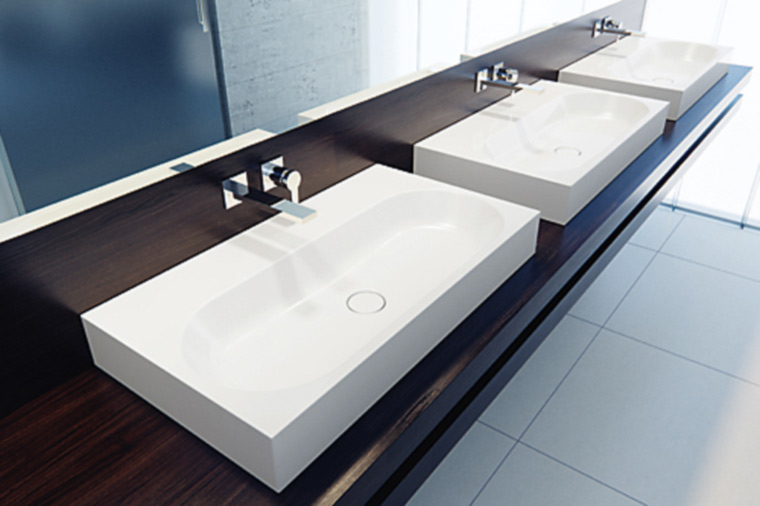Private bathrooms have long since developed into independent oases of relaxation with comfortable fittings and furnishings. The highest requirements for the sanitary facilities have to be considered when modernising semi public and public sanitary rooms: due to the high frequency of use and the changing users, hygiene, functionality and robustness are particularly important, as the brand manufacturers from the Blue Responsibility initiative know.
Semi public and public toilet areas with a high frequency of use are subject to a high risk of soiling and vandalism. The high level of anonymity is a recurrent problem with unhygienic consequences. Blue Responsibility offers product solutions which are easy to clean and function reliably while offering comfort at the highest level. “A sanitary room in the hotel and restaurant industry, in leisure facilities or in office and administration buildings is like a calling card,” Veit Szpak from Mepa says. “Public toilets are no longer just functional, but rather make an essential contribution to the image of the establishment.”
High quality materials for long term maintenance
A washbasin tap which is used about 40 to 60 times a day in a private bathroom is used ten or even a hundred times more often in a public facility. Durability of the taps is therefore essential: “If products fail less often, this causes fewer repairs,” Christoph Reiß from Kludi explains. “It is better to invest in high quality taps once and then benefit in the long term.” The electronic taps from Kludi are reduced to five litres of water flow per minute and are therefore ideal for use in public facilities. For the modernisation of a leisure pool, Schell integrated full metal taps with high quality chrome surfaces for best possible protection against vandalism. These provide the required robustness for public sanitary facilities and are also easy to clean. “The use of high quality materials is the best means against vandalism,” Verena Töpfer-König from Franke Aquarotter says. “The more inviting a sanitary room is, the more it will be appreciated and therefore used with more care.”
Different materials are suitable for aesthetically pleasing and durable washbasins. Burgbad relies on unbreakable cast mineral which consists of 80 per cent natural materials and 20 per cent high quality, unsaturated polyester resin. Franke Aquarotter primarily uses the cast mineral material Miranit for washbasins: the smooth and porefree outer skin is easy to clean and virtually resistant to lye and acid. Should the surface still become damaged, special repair sets can help to mend them.
The enamelled steel washbasins from Kaldewei also feature extraordinary durability and stability. They show no signs of wear even after years of use. “With this, we ensure longer renovation cycles and lower operating costs,” Marcus Möllers from Kaldewei explains.
The mineral material Varicor, which is used by Geberit, is suitable for washbasins due to its robustness and easy care properties. The poreless material offers absolute flexibility – from high precision installation to individual custom models. Stainless steel meets these requirements with regard to hygiene and durability. “Stainless steel actuation plates were installed during the modernisation of the Skaters Palace, a trendy skateboarding location in Münster. The material not only matches the industrial style of the hall, it is also easy to clean,” Volker Röttger from Geberit says.
Intuitive operation in public spaces
Not only the materials have to be suitable for public facilities – the functionality should also be self-explanatory: If people from all over the world come together at international airports, everyone should be able to operate the actuation plates. For this and other reasons, electronic actuation plates for contactless operation have long since proven successful. “Contactless actuation plates with optional stagnation flushing systems are the optimal feature for public sanitary facilities,” Jens Gebers from Schell says. “They provide long term hygiene and a conscious use of resources.” The switching times can be defined exactly to counteract water waste and save energy.
Modern toilets for a feelgood atmosphere
To avoid unpleasant odours, Mepa, for example, offers an intelligent WC solution: odours are extracted directly so that they have no chance to spread through the room. The waterless extraction urinals from Ideal Standard also let liquids pass through while preventing odours from entering the room. “A siphon valve automatically indicates when it has to be replaced,” Thomas Kreitel from Ideal Standard explains. One particular highlight from this sanitary manufacturer is a toilet seat made of a pleasant thermoplastic material: it discharges silver ions to prevent germs and bacteria from spreading. “The toilet seats are proven the be free from germs again within only 15 minutes after use.” Thanks to innovative solutions from the German sanitaryware industry, users of (semi) public sanitary facilities can also feel comfortable in the toilet area in the long term.
Sustainable modernisation
The topics of hygiene and functionality are at the centre of modernisation projects in (semi) public sanitary facilities. “In addition to innovative product solutions, the atmosphere is crucial to how carefully and respectfully people treat the room,” Katja Zimmermann from Keuco explains. Lighting and acoustics as well a tasteful composition of the products are highlights which turn a public space into a feelgood area. “A sanitary facility with a high quality design is worth the investment, as it protects against improper use and ensures that the space will be respected by users in the long term,” Wolfgang Burchard from Blue Responsibility says.
Further details regarding this topic can be obtained on the manufacturers' websites www.burgbad.de, www.franke.com, www.idealstandard.de, www.kaldewei.de, www.geberit.de, www.keuco.de, www.kludi.com, www.schell.eu and www.mepa.de.
